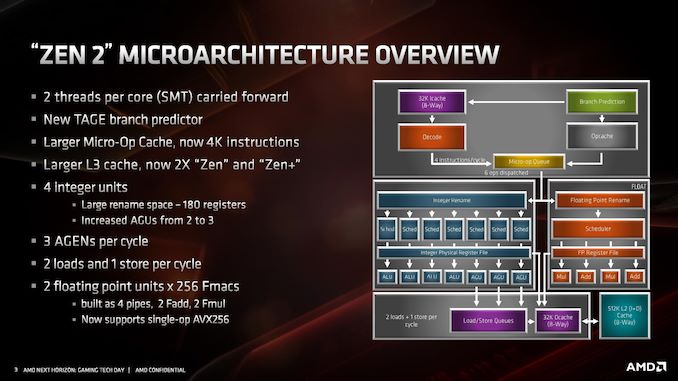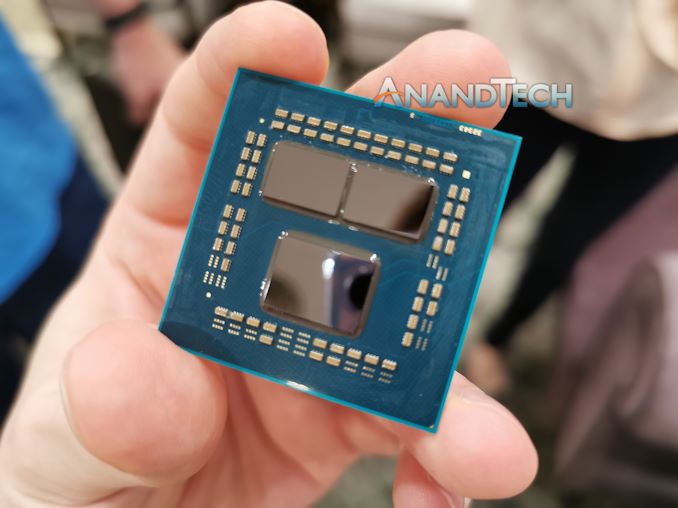AMD Zen 2 Microarchitecture Analysis: Ryzen 3000 and EPYC Rome
by Dr. Ian Cutress on June 10, 2019 7:22 PM EST- Posted in
- CPUs
- AMD
- Ryzen
- EPYC
- Infinity Fabric
- PCIe 4.0
- Zen 2
- Rome
- Ryzen 3000
- Ryzen 3rd Gen
Building a core like Zen 2 requires more than just building a core. The interplay between the core, the SoC design, and then the platform requires different internal teams to come together to create a level of synergy that working separately lacks. What AMD has done with the chiplet design and Zen 2 shows great promise, not only in taking advantage of smaller process nodes, but also driving one path on the future of compute.
When going down a process node, the main advantages are lower power. That can be taken in a few ways: lower power for operation at the same performance, or more power budget to do more. We see this with core designs over time: as more power budget is opened or different units within the core get more efficient, that extra power is used to drive cores wider, hopefully increasing raw instruction rate. It’s not an easy equation to solve, as there are many trade-offs: one such example in the Zen 2 core is the relationship between the reduced L1 I-cache that has allowed AMD to double the micro-op cache, which overall AMD expects to help with performance and power. Going into the minutae of what might be possible, at least at a high level, is like playing with Lego for these engineers.
All that being said, Zen 2 looks a lot like Zen. It is part of the same family, which means it looks very similar. What AMD has done with the platform, enabling PCIe 4.0, and putting the design in place to rid the server processors of the NUMA-like environment is going to help AMD in the long run. The outlook is good for AMD here, depending on how high it can drive the frequency of the server parts, but Zen 2 plus Rome is going to remove a good number of questions that customers on the fence had about Zen.
Overall AMD has quoted a +15% core performance improvement with Zen 2 over Zen+. With the core changes, at a high level, that certainly looks feasible. Users focused on performance will love the new 16-core Ryzen 9 3950X, while the processor seems nice an efficient at 105W, so it will be interesting so see what happens at lower power. We're also anticipating a very strong Rome launch here over the next few months, especially with features like double FP performance and QoS, and the raw multithreading performance of 64 cores is going to be an interesting disruptor to the market, especially if priced effectively. We’ll be getting the hardware on hand here soon to present our findings when the processors are launched on July 7th.












216 Comments
View All Comments
fmcjw - Tuesday, June 11, 2019 - link
All good and fine, but I want Zen 2 and 7nm on my laptop. If they aren't announcing it today, products aren't gonna ship by holiday 2019, and most consumers will end up buying 10nm Intel devices. Missed chance.mode_13h - Tuesday, June 11, 2019 - link
Eh, they have perfectly good 12 nm laptop SoCs. 7 nm would've been nice, but it's hard to do everything at once.levizx - Tuesday, June 11, 2019 - link
Nope, those 12nm APUs have worse battery life (than current 8th Gen) and no TB3/USB4 support. I can't think of a reason where I would choose Ryzen 3xxxU over Ice Lakemode_13h - Tuesday, June 11, 2019 - link
Do price & availability count?Xyler94 - Tuesday, June 11, 2019 - link
Misleading remarks. Huawei was able to make a Ryzen APU have better battery life than an 8th gen processor. TB3 and USB4 aren't readily used mainstream yet. Heck USB-C hasn't even caught on yet.Currently laptop makers aren't optimizing AMD's CPU, that's just the fact.
Cooe - Wednesday, June 12, 2019 - link
This is mostly nonsense. Performance AND battery life for Ryzen Mobile 2nd Gen is extremely close to Intel's current 8th & 9th gen 4-core parts. And until Ice Lake is a real thing that you can actually buy, Ryzen still has a major value advantage + far better iGPU performance. Ice Lake also isn't really any faster CPU wise than Whiskey Lake, because despite increasing IPC by +18%, clock-speeds were dropped from 4.8 to 4.1GHz, or about -16%, erasing nearly all those gains.fmcjw - Tuesday, June 11, 2019 - link
Yeah, I get that they still need time to get the GPU down to 7nm, so they pushed it back to focus on the CPU for desktop (where performance per watt matters much less than server or mobile). But the silence is not reassuring, and mobile-wise, Zen is still inferior to Intel, maybe not performance-wise as Huawei demonstrates with its Matebook, but definitely battery-wise because of the more powerful GPU.scineram - Tuesday, June 11, 2019 - link
Nobody is going to buy Shintel vaporware. Or only very few.The_Assimilator - Tuesday, June 11, 2019 - link
Please edit the table on page 1 to combine the rows with identical values into a single row (e.g. the RAM speed). Also edit the 3950X price to have a ? after it as it's not yet confirmed.jfmonty2 - Tuesday, June 11, 2019 - link
The 3950X price is most definitely confirmed; Lisa Su said it loud and clear (and showed it on the slide) in AMD's E3 presentation yesterday: https://www.youtube.com/watch?v=yxPBXNuX6Xs&t=...